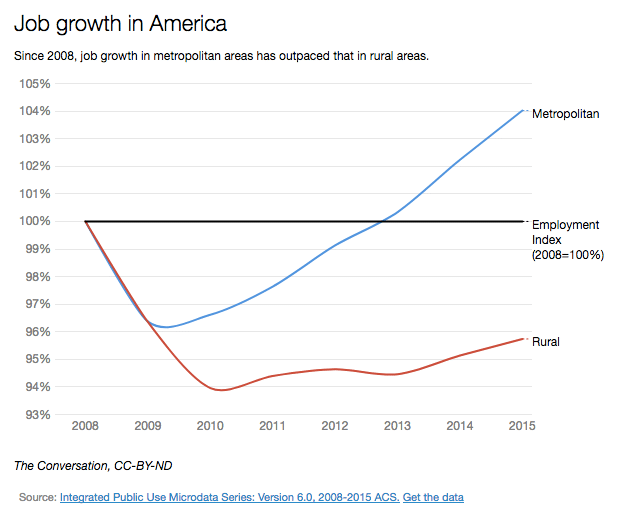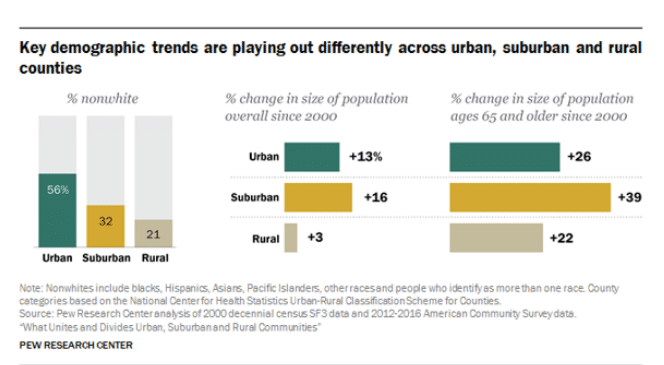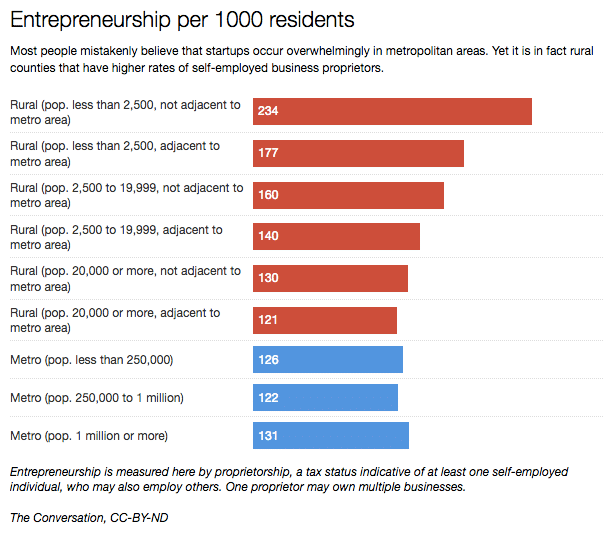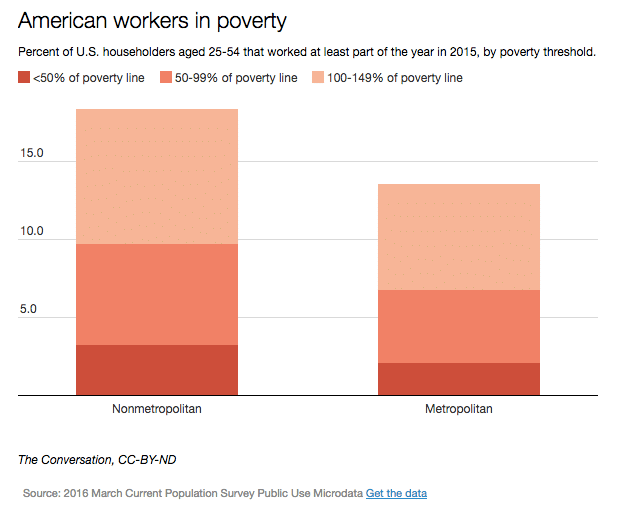The political map of the US increasingly represents a divided America, and this political divide has roots in an increasing economic divide.
In brief – rural areas tend to have lower average incomes (though also cheaper rent) higher rates of unemployment, declining population, reliance on one major employer and more concentrated on the primary sector – farming, mining and commodity extraction.

By contrast, metropolitan urban areas have seen faster rates of population growth, higher levels of immigration, rising average incomes (though also rising rents) and have become magnets for large technological giants setting up business in these dense, heavily populated areas.

Source: Rural and Urban divide in America
The urban-rural divide can become exaggerated. For example, contrary to popular belief, there are higher levels of entrepreneurs in rural areas than in urban areas.

Also, though rural areas have lower average incomes – this is mitigated by cheaper living costs. Also, it is not just rural areas experiencing rising poverty levels. The fastest rates of increasing poverty levels have been in suburban areas. But, population migration is telling. Highly educated, young rural population have been migrating to the cities. This has caused a negative regional multiplier effect, with less investment and new opportunities in rural areas.
Large tech firms like Google, Amazon and Apple tend to cluster in metropolitan areas which are already prosperous and heavily populated, creating further net regional migration pulls.
American workers in poverty

According to US census – in 2015, 16.7 percent of the rural population was poor, compared with 13.0 percent of the urban population overall – and 10.8 percent among those living in suburban areas outside of principal cities.
A large portion of the poor are the working poor – minimum wage jobs or temporary contracts. Falling unemployment rates have not seen growth in real wages for the lowest paid.
Reasons for rural-urban economic divide
- Increased concentration of new tech/service sector economy. While the internet, in theory, makes it easier to work from anywhere in the world. Major IT firms have preferred to invest in large metropolitan areas. This gives them the best access to skilled labour. It also gives an infrastructure and culture suited to the new fast-moving technological sector.
- Rural areas tend to have a smaller pool of skilled labour (college educated labour) and therefore are less attractive to investment. In addition, to the issue of skilled labour there are other issues, such as infrastructure and how desirable a place is to live in.
- Regional Migration. Rural areas have seen net migration to urban areas. This is especially the case with younger more educated workers who are willing to move to seek better employment opportunities. But, with losing young, educated workers it has a negative effect on the rural economy.
- Cultural factors. In an increasingly polarised cultural and political country, there is an attraction to living amongst ‘like-minded’ people. Urban areas have higher levels of immigration and non-white ethnic groups. Rural areas are less diverse and conservative. Amazon recently announced its second headquarters in New York which maybe due to economic reasons, but there may also be an issue of ‘cultural compatibility.’ It’s hard to imagine Google setting up in Wyoming – even if the economic infrastructure was there.
- Income-elasticity of demand for sectors. Economic growth tends to benefit goods/services with a higher income elasticity of demand – IT, service sector, entertainment. Commodities, farming and mining, have a lower income elasticity of demand. With rising incomes, there is a smaller proportionate increase in demand for these basic commodities, so there is less growth in rural areas.
Other potential factors
- Globalisation – outsourcing of manufacturing jobs, greater competition in manufacturing/ agriculture.
- Lack of public sector infrastructure in America.
Problems of the rural-urban economic divide
- Self-fulfilling problem. Rural decline and urban growth is creating a ‘feedback loop‘ to strengthen the initial imbalance. Workers and firms are attracted to the growth in metropolitan areas (positive feedback loop). Workers are more inclined to leave rural areas. (negative feedback loop)
- The sense of left-behind. There is a sense of grievance in rural areas to witness the relative decline in the economy and experiencing a relative decline in incomes, opportunities and high-quality jobs like in the past.
- Link between poverty and poor health/opioid addiction.
- Overpopulation in metropolitan areas. The growing population and wealth of metropolitan areas have led to increased congestion, unaffordable rents and the increased ‘gentrification’ of areas making them unaffordable. Average incomes may be higher, but the cost of living has become prohibitive for many people renting inexpensive city areas.
Related
- Rust belt – definition and meaning
- Winners and losers from globalisation
- Problem of declining industries
